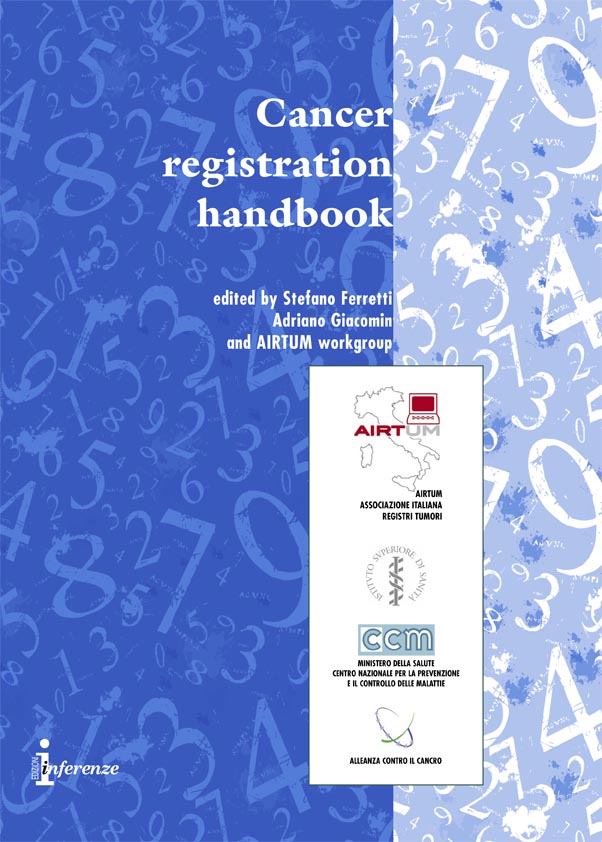
Cancer Registration Handbook è la versione inglese del Manuale di Tecniche di registrazione dei Tumori pubblicato da AIRTUM nel gennaio 2008
Edited by:
Stefano Ferretti - Registro Tumori della provincia di Ferrara, Università di Ferrara
Adriano Giacomin - Registro Tumori Piemonte, provincia di Biella, CPO - ASL BI
and the AIRTUM Workgroup
Authors:
Francesco Bellù Registro tumori dell’Alto Adige-Tumorregister Südtirol
Tiziana Cassetti Registro tumori Umbro di popolazione
Luigino Dal Maso CRO Aviano
Corrado Magnani Registro tumori Infantili del Piemonte
Silvia Patriarca CPO-Registro tumori Piemonte, Città di Torino
Maurizio Ponz de Leon Registro dei tumori Colorettali di Modena
Ivan Rashid Registro tumori della Provincia di Modena
Piera Vicari CPO-Registro tumori Piemonte, Città di Torino
Susanna Vitarelli Registro tumori della Provincia di Macerata
Acknowledgements:
Antonio Ponti (CPO - Centro per la Prevenzione Oncologica Piemonte), helped revise the sections concerning the relationship between registration and screening. We would also like to thank all colleagues who submitted comments and editing suggestions.
This handbook was written by the cancer registration workgroup of the Italian Cancer Registry Association (AIRTUM) as part of a project of the Ministry of Health’s Center for Disease Control.
- Contents (download pdf)
- List of abbreviations (download pdf)
- Introduction (download pdf)
- Chapter 1: Registry fundamentals (download pdf, go to contents)
- Chapter 2: Registration (download pdf, go to contents)
- Chapter 3: Classification (download pdf, go to contents)
- Chapter 4 (part 1): Specific tumor sites (download pdf, go to contents)
- Chapter 4 (part 2): Specific tumor sites (download pdf, go to contents)
- Chapter 4 (part 3): Specific tumor sites (download pdf, go to contents)
- Chapter 4 (part 4): Specific tumor sites (download pdf, go to contents)
- Chapter 5: Managing and controlling the database (download pdf, go to contents)
- Appendix 1: Check-RT (download pdf, go to contents)
- Appendix 2: SALI (download pdf, go to contents)
- Appendix 3: INCAS-AIRTUM (download pdf, go to contents)
You can download also the zip file with all parts (![]() 13,4M).
13,4M).
CHAPTER 1
Registry fundamentals
Contents
I-2 Introduction
I-2 General registration procedures
I-3 Population-based registries and special registries
I-3 Formalization
I-3 Founding
I-3 Relations with AIRTUM
I-4 Relations with IARC
I-4 Relations with ENCR and IACR
I-4 Organization
I-4 Group structure
I-4 Training
I-4 Defining projects and methods
I-5 Registries and mortality data
I-5 Accreditation
I-5 Rules
I-6 Accreditation procedures and methods
I-6 Periodic audits of accredited registries
I-7 References
Registration
Contents
II-2 Reportable cases
II-2 Incident cases
II-3 Residence
II-3 Laterality and paired organs
II-3 Premalignant lesions
II-4 Lesions of uncertain behavior
II-4 Data sources
II-4 Public register sources
II-6 Mandatory sources of information
II-6 Additional sources of information
II-6 Critical aspects of current sources of information
II-8 Record linkage systems
II-8 Data collection
II-8 Standard layout
II-8 Incidence
II-9 Mortality
II-9 Populations
II-9 A closer look at certain essential variables
II-10 Extension and staging
II-11 The TNM classification
II-11 “Condensed” TNM
II-12 Further information on extension and staging
II-12 Treatment
II-13 Interaction with special registries
II-13 Screening programs
II-15 References
II-16 Tables
Classification
Contents
III-2 Introduction
III-2 ICD-O rules
III-3 IARC/IACR and ENCR rules
III-3 Multiple primaries
III-4 Evaluation for incidence
III-5 Evaluation for registration
III-5 Management of relapses
III-5 Multiple primaries and survival
III-6 Tumors with no microscopic confirmation
III-6 Cases of uncertain interpretation
III-6 Assignment of topography in neo-organs
III-6 Assignment of a specific morphology in the absence of microscopic confirmation
III-6 Markers
III-7 Diagnostic imaging
III-7 Endoscopic diagnostics
III-7 Exploratory surgery/autopsy
III-7 Clinical diagnostics and treatment
III-7 Post-mortem diagnoses
III-8 Cytogenetic and molecular diagnosis
III-8 Refutable or ineffective diagnoses
III-8 Managing special cases
III-8 Not sure eligibility (NSE) cases
III-9 DCI and DCO cases
III-11 Correct coding in a few specific instances
III-12 Special cases
III-13 Prevalent cases
III-13 Non resident cases at diagnosis
III-13 Cases identified after incidence has been “closed”
III-14 Autopsy in cancer carriers
III-14 References
III-15 Tables and figures
Specific tumor sites (part 1)
Contents
IV(1)-2 Lip cancer
IV(1)-2 Tumors of the upper aerodigestive tract
IV(1)-3 Salivary gland neoplasms
IV(1)-3 Gastrointestinal cancer
IV(1)-3 Esophagus
IV(1)-3 Stomach
IV(1)-4 Small intestine
IV(1)-4 Bowel
IV(1)-7 Liver, bile ducts, and pancreas
IV(1)-7 Lung cancer
IV(1)-7 Mesothelioma
IV(1)-8 Sarcomas
IV(1)-8 Skin cancer
IV(1)-8 Melanoma
IV(1)-9 Other malignant skin tumors
IV(1)-9 Kaposi’s sarcoma
IV(1)-9 Breast cancer
IV(1)-9 Registration techniques
IV(1)-10 References
IV(1)-11 Tables
Specific tumor sites (part 2)
Contents
IV(2)-2 Cancer of the female genital organs
IV(2)-2 Cervix
IV(2)-3 Uterus
IV(2)-3 Ovary and Fallopian tube
IV(2)-3 Female genital organs, other sites
IV(2)-3 Cancer of the male genital organs
IV(2)-3 Prostate
IV(2)-4 Penis, scrotum, testicle
IV(2)-4 Urinary tract cancer
IV(2)-4 Bladder and urinary tract
IV(2)-6 Kidney
IV(2)-7 Central nervous system (CNS), peripheral nervous system,
and intracranial-intraspinal neoplasms
IV(2)-7 Reportable cases
IV(2)-8 WHO histological grade
IV(2)-8 Endocrine gland neoplasms
IV(2)-8 Pituitary gland
IV(2)-8 Thyroid, parathyroid glands
IV(2)-8 Endocrine pancreas
IV(2)-8 Adrenal gland
IV(2)-8 Carcinoid tumors
IV(2)-9 References
IV(2)-10 Tables
Specific tumor sites (part 3)
Contents
IV(3)-2 Lymphohematopoietic cancer
IV(3)-2 Lymphomas
IV(3)-10 Plasma cell, mast cell, and histiocytic neoplasms, and immunoproliferative disorders
IV(3)-12 Leukemia
IV(3)-15 Chronic myeloproliferative and myelodysplastic disorders
IV(3)-18 Multiple hematological neoplasms
IV(3)-19 Outpatient incidence date
IV(3)-19 References
IV(3)-21 Tables
Specific tumor sites (part 4)
Contents
IV(4)-2 Rare tumors
IV(4)-2 Childhood cancer
IV(4)-3 Piedmont childhood cancer registry
IV(4)-5 References
IV(4)-6 Table
Managing and controlling the database
Contents
V-2 Population base
V-2 Data sources and resident population present
V-2 Indicators
V-2 Number of cases
V-3 Proportional distribution
V-3 Crude rate
V-3 Standardized rate
V-3 Cumulative risk
V-3 Mortality/incidence ratio
V-3 Years of life lost/gained
V-3 Survival
V-3 Prevalence
V-3 Time trends
V-4 Standard errors and confidence intervals for the indicators
V-4 Index calculation programs
V-4 CanReg
V-4 SEERStat
V-5 Error control
V-5 Data entry procedures
V-5 Programs for controlling the precision of data
V-7 Checking the completeness of records
V-10 Revisions and updates
V-10 Follow-up
V-10 References
Contents
APP.1-2 User’s Guide to CheckRT: Software for Quality Control
APP.1-2 Importing the case file
APP.1-3 Importing mortality data
APP.1-4 Importing the population
APP.1-5 Other import features and advanced settings
APP.1-6 Analyzing the data
APP.1-8 Restrictions and system requirements
Contents
APP.2-2 User’s Guide to SALI : Software for Record Linkage
APP.2-2 Instructions for linkage using SALI
APP.2-4 Other features of the software
APP.2-5 References
Contents
APP.3-2 User’s Guide to INCAS-AIRTUM: Software for Selection of HDD and Mortality Listings
APP.3-2 Operation
APP.3-2 Note
